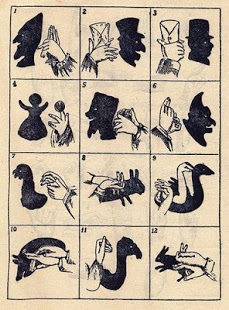توضیحات شکل سایه
سایه بازی یا خیمه شب بازی سایه، سرگرمی باستانی که در آن، شخص اجرا کننده با دستان خود، حالتهایی را به وجود میآورد که سایه تشکیل شده به شکلهای گوناگونی مانند حیوان، جادوگر و ... دیده میشود.
این بازی در بیش از 20 کشور به صورت عمومی شناخته شده بوده و محبوبیت فراوانی دارد.
در این نرم افزار، میتوانید نحوه کنار هم قرار دادن دستان خود برای ایجاد چنین اشکالی را بیاموزید.
The description of Hand Shadow Puppets Ideas
Hand Shadow Puppets or Shadow play or also known as shadow puppetry is an ancient form of storytelling and entertainment which uses flat articulated figures (shadow puppets) to create cut-out figures which are held between a source of light and a translucent screen or scrim. The cut-out shapes of the puppets sometimes include translucent color or other types of detailing. Various effects can be achieved by moving both the puppets and the light source. A talented puppeteer can make the figures appear to walk, dance, fight, nod and laugh.
Shadow play is popular in various cultures; currently there are more than 20 countries known to have shadow show troupes. Shadow play is an old tradition and it has a long history in Southeast Asia; especially in Indonesia, Malaysia, Thailand and Cambodia. It is also considered as an ancient art in other parts of Asia such as in China, India and Nepal. It is also known in the West from Turkey, Greece to France. It is a popular form of entertainment for both children and adults in many countries around the world.
Shadow puppetry originated during the Han Dynasty when one of the concubines of Emperor Wu of Han died from an illness. The emperor was devastated, and he summoned his court officers to bring his beloved back to life. The officers made a shape of the concubine using donkey leather. Her joints were animated using 11 separate pieces of the leather, and adorned with painted clothes. Using an oil lamp they made her shadow move, bringing her back to life.Shadow theatre became quite popular as early as the Song Dynasty when holidays were marked by the presentation of many shadow plays. During the Ming Dynasty there were 40 to 50 shadow show troupes in the city of Beijing alone. In the 13th century, the shadow show became a regular recreation in the barracks of the Mongolian troops. It was spread by the conquering Mongols to distant countries like Persia, Arabia, and Turkey. Later, it was introduced to other Southeastern Asian countries. The earliest shadow theatre screens were made of mulberry paper. The storytellers generally used the art to tell events between various war kingdoms or stories of Buddhist sources.[1] Today, puppets made of leather and moved on sticks are used to tell dramatic versions of traditional fairy tales and myths. In Gansu province, it is accompanied by Daoqing music, while in Jilin, accompanying Huanglong music forms some of the basis of modern opera.
The origins of Taiwan's shadow puppetry can be traced to the Chaochow school of shadow puppet theatre. Commonly known as leather monkey shows or leather shows, the shadow plays were popular in Tainan, Kaohsiung, and Pingtung as early as the Qing dynasty (1644-1911 A.D.). Older puppeteers estimate that there were at least a hundred shadow puppet troupes in southern Taiwan in the closing years of the Qing. Traditionally, the eight to 12-inch puppet figures, and the stage scenery and props such as furniture, natural scenery, pagodas, halls, and plants are all cut from leather. As shadow puppetry is based on light penetrating through a translucent sheet of cloth, the "shadows" are actually silhouettes seen by the audience in profile or face on. Taiwan's shadow plays are accompanied by Chaochow melodies which are often called "priest's melodies" owing to their similarity with the music used by Taoist priests at funerals. A large repertoire of some 300 scripts of the southern school of drama used in shadow puppetry and dating back to the fourteenth and fifteenth centuries has been preserved in Taiwan and is considered to be a priceless cultural asset.
A number of terms are used to describe the different forms.
-a shadow theatre using leather puppets. The figures are usually moved behind a thin screen and is not entirely a show of shadows as it is more of a silhouette shadow. This gives the figures some color, and is not 100% black and white.
-paper shadow theatre.
-Chinese shadow theatre.

 تماشای ایستگاه فضایی
ISS Live Now: Live HD Earth View and ISS Tracker
تماشای ایستگاه فضایی
ISS Live Now: Live HD Earth View and ISS Tracker
 دیکشنری تحلیلگران
Tahlilgaran Dictionary
دیکشنری تحلیلگران
Tahlilgaran Dictionary
 پرسان - پرسش و پاسخ درسی دبیرستان
Porseman
پرسان - پرسش و پاسخ درسی دبیرستان
Porseman
 لرنیت - آموزش زبان انگلیسی
Learnit
لرنیت - آموزش زبان انگلیسی
Learnit
 دولینگو - یادگیری رایگان زبان
Duolingo: Learn Languages Free
دولینگو - یادگیری رایگان زبان
Duolingo: Learn Languages Free
 قوانین و اخبار حقوقی
Dideban Hashtom
قوانین و اخبار حقوقی
Dideban Hashtom
 یادگیری نقاشی سه بعدی
Learn to Draw 3D
یادگیری نقاشی سه بعدی
Learn to Draw 3D
 یادگیری تکلم انگلیسی
Learn to Speak English
یادگیری تکلم انگلیسی
Learn to Speak English
 یو دیکشنری
U-Dictionary: Oxford Dictionary Free Now Translate
یو دیکشنری
U-Dictionary: Oxford Dictionary Free Now Translate















